Professor of Traditional Landscape Architecture, Korean National
University of Cultural Heritage
Korean gardens embody a philosophy
of adapting to nature in its
original state. The elements of a Korean garden include land,
structures, flowers and trees, streams and ponds, rocks and walls,
bridges and paths. A garden brings these elements together into harmony
within a defined space through an orderly and functional arrangement.
.
In a garden, Koreans enjoy a
sense of inner peace from becoming one with nature. Gardens can also
serve practical purposes, such as for growing fruit or medicinal herbs,
in addition to being delightful playgrounds. Sometimes they are used as
an inspirational backdrop for writing poetry, or a spiritual training
ground for
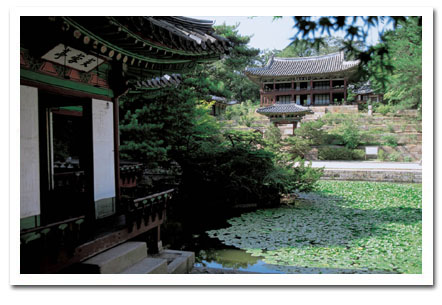
meditation.
The influences that shaped the identity of the
Korean garden include Korea's natural environment as well as the
lifestyle and ideological values of its people, which have changed with
the times.
.
.
Nature in the Traditional Garden
.
The Korean peninsula's three
coasts are lapped by the ocean, while its mountains, rivers, fields,
and seas stand out in sharp contrast, amid a constant changing of its
distinctive seasons. Accordingly, the inhabitants of long ago spoke of
their beautiful land as "embroidered rivers and mountains." The land of
Korea is free from major earthquakes and active volcanoes. Rain falls
in quantities conducive for agriculture, while the climate is
relatively mild.
.
As a result, the people could
maintain a stable livelihood by working hard in accordance with the
principles of nature. It was thus natural for Koreans to think of
nature as a motherly being who takes care of mankind. To Koreans,
nature was both an eternal spiritual essence and a comforting maternal
figure. Accordingly, the indigenous religion of Korea was centered on
the worship of nature. Koreans believed that life would not be possible
unless the principles of nature were respected.
.
The conceptual roots of Korean
culture lie in the worship of nature. The imported ideology of Buddhism
was added to this around the fourth century, while Taoist thought
became widely disseminated about the seventh century. It was from this
ideological background that the Korean garden was created. From the
15th century, the Song Confucianism of Zhu xi became the ruling
ideology of Joseon, along with landscape architecture coming under the
influence of such concepts as yin-yang, the five elements, and
geomancy.
.
In particular, Song
Confucianism's view of nature strongly influenced Joseon gardens. It
was through these influences that Joseon art was created, with its
naturalistic style untouched by artifice, while a worldly, practical
lifestyle flourished, based on moderation and diligence. Indeed, this
led to the development of a highly humanistic and straight-forward
naturalistic culture.
.
Korea's cultural heritage
includes nothing as monumental or imposing as the Great Wall of China
or the Grand Canal that links the Yellow River to the Yangtze River.
This is because Koreans believe that anything so huge will overwhelm
and alienate human beings. On the other hand, Japanese have long
suffered from natural disasters such as earthquakes, volcanoes,
typhoons, and tidal waves. As such, they were able to survive only by
overcoming these menacing forces of nature. As a reflection of this,
Japanese gardens feature a contrived sense of aesthetics. All Oriental
gardens are rooted in concepts about nature, but because of differences
in their respective natural environment, lifestyle, and values, the
gardens of Korea, China, and Japan each possess their own unique
characteristics.
Gyerim Grove and Anapji Pond
.
The Gyeongju Historic Areas,
included on the list of UNESCO World Heritage sites, contains relics of
gardens from the Silla Kingdom (57 B.C.-A.D. 935). Situated
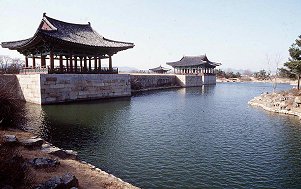
around
Wolseong, the site of the Silla royal palace from 101 to 935, are
Gyerim Grove and Anapji, the pond of Silla's East Palace. During the
Silla period, the pond was known as Wolji or "Moon Pond," and it was
not until the Joseon era that poets and men of letters started to call
it Anapji, "Wild Goose and Duck Pond," for its abundant growth of reeds
and duckweed that made it a popular rest stop for wild geese and ducks.
.
The 7,723-square-meter Gyerim
is Gyeongju's sacred woodland area and the birthplace of Kim Al-ji,
founder of the illustrious Gyeongju Kim clan. Thick with zelkova trees
and wangbeodeul (salix Koreensis Anderss.), it is known as Korea's
oldest woodland. Moreover, from A.D. 65 to 307, Gyerim was used as the
name of the Silla Kingdom itself. Home to the oldest trees of all
Korea's ancient gardens, this grove is steeped in legend.
.
The remains of Anapji, the
pond of Silla's East Palace, were uncovered by an excavation team in
1975. According to Samguksagi (History of the Three Kingdoms), in the
12th month of the 14th year of King Munmu's reign (A.D. 674), "a pond
was dug within the palace grounds, where artificial mountains were
constructed, and flowers, rare birds, and deer brought." The section on
Gyeongju in the Donggungnyeoji-seungnam (Augmented Survey of the
Geography of Korea) states: "Anapji lies to the north of Cheonjusa
Temple, where King Munmu created a pond within the palace grounds,
piled up stones to make mountains symbolizing the 12 peaks of Mt. Musan
(Wuehan in Chinese), and brought in flowers and birds. To the west is
the site of Imhaejeon Pavilion, whose stone foundation and steps remain
in an open field." Anapji Pond extends some 190 meters from east to
west as well as north to south, encompassing an area of 15,658 square
meters and with stone-trimmed banks. To the east and north of the pond,
artificial mountains were built to symbolize the 12 peaks of Mt. Musan,
while palace buildings stood to the west and south. The sloped eastern
bank resembled an exquisitely curved coastline, and within the pond
were three islands symbolizing Samsinsan, or "Three God Mountains."
Along the banks of the pond and the slopes of the man-made mountains
were three beautiful arrangements of about a thousand uniquely shaped
rocks, each a little less than a man's height.
.
Anapji was a garden conceived
as a scaled-down version of the world of Taoist immortals. The method
of arranging the intriguingly shaped rocks is similar to a technique
described in the oldest record of Japanese gardening, the 11th-century
Skuteiki. From this source, we can see that the entrance where the
water flowed in was also similar to a Japanese garden. It seems likely
that Korean garden landscaping influences were eventually transmitted
to Japan.
.
.
Changdeokgung Huwon Garden
.
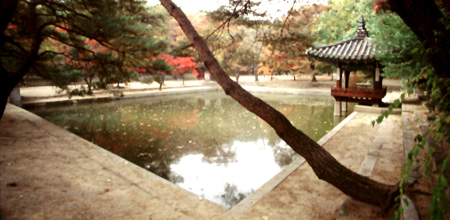
The most significant
palace
garden remains of the Joseon era (1392-1910) is the Huwon garden of the
Changdeokgung Palace, commonly known as "Rear Garden." Built in 1405,
Changdeokgung served as a royal palace through 1910 for successive
kings of the Joseon Dynasty and the Emperor of the Daehan Empire
(1897-1910). In 1997, Changdeokgung and its Huwon garden was added to
the list of UNESCO World Heritage properties, making this
world-acclaimed garden a must-see attraction for sightseers in Seoul.
.
The Huwon garden covers an
area of about 300,000 square meters, with its highest point reaching 98
meters above sea level. Arranged in harmony with the landscape, and not
unduly dominating the hillside, are 17 pavilions, including
Buyongjeong, Aeryeonjeong, Huiujeong, Jondeokjeong, Taegeukjeong, and
Cheongsimjeong. Nearby buildings include Juhamnu, Yeongyeongdang,
Yeonghwadang, and
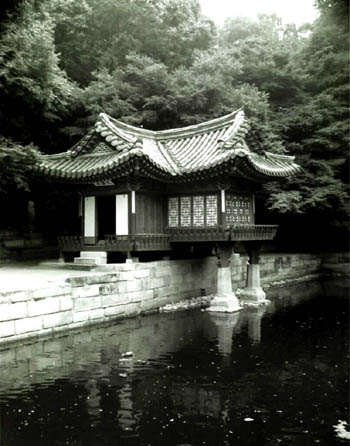
Seonhyangjae. The ponds, mostly round in shape,
include Buyongji, Aeryeonji, Jondeokji, Banwolji, Eosutaekji, and
Gwallamjeongji.
.
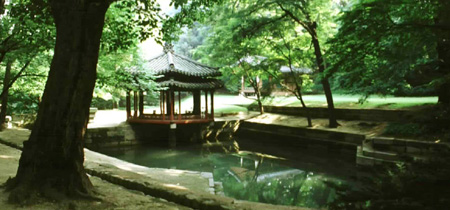
The area is home to
several
extraordinary trees, including a 700-year-old darae namu (Actinidia
arguta), 600-year-old Chinese juniper, and zelkova tree several hundred
years old, along with various dolbae namu (Rosaceae Pyrus pyrifolia
(Burm.) Nakai), mulberry, chestnut, yew, pagoda tree, white oak, and
overcup oak. There are also shrubs and bushes under 3 meters in height:
about 300 species of plants in all. Among them, these darae namu and
Chinese juniper have been designated natural monuments.
.
Distinctively shaped rocks are
arranged around the pavilions, walls, and flowerbeds, together with
landscaping along the sloping banks. Attractive stone bridges cross a
little stream. There are fruit trees, mulberry trees for silk worms,
apricots, Japanese apricots, cherries, and peonies, while taller trees
such as zelkova and pagoda trees form a lush woodland.
.
Although Huwon is a man-made
garden, its natural beauty is magnificent. Walking the 2-kilometer path
through the garden, people can feel that they have become one with
nature. In fact, Korean kings would often visit the garden to consult
with their confidants and contemplate weighty matters.
.
.
Heewon Garden
.
Soswaewon garden, located in
Jigok-ri Village, Nam-myeon, Damyang-gun, Jeollanam-do province, was
created by the scholar Yang San-bo during the reign of Joseon's King
Jungjong (r. 1506-1544). Within a 9,900-square-meter area surrounded by
boulders, Gwangpunggak Pavilion, Jewoldang Hall, flowerbeds, ponds, a
single-log bridge, and a water wheel create a picturesque landscape.
The garden is imbued with the philosophy of scholars who enjoyed a
self-sufficient lifestyle while immersed in nature and scholarly
pursuits.
.
Soswaewon clearly reflects its
creator's desire to abide by the principles of nature. In particular,
the garden makes extensive use of natural features, whose original
state is maintained as much as possible. The garden is a representation
of the ideal world that scholars sought to find when they retreated
from public life to the
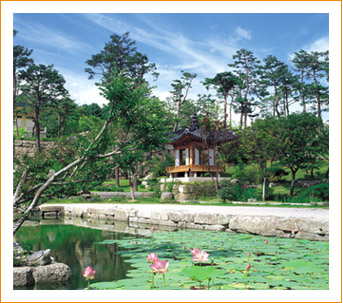
solitude of the countryside.
.
Deep in a valley on Bogildo
Island, Wando-gun, Jeollanam-do, lies Buyongjeong, a garden created by
the Joseon poet Yun Seon-do. At the entrance to the garden, Yun built
Seyeonjeong Pavilion, alongside a gyeryu (small stream), and a
2,000-square-meter pond with banks formed of flat stones about 11
meters in length. Nearby, he built another pond of about 820 square
meters in area, in addition to installing Dongdae and Seodae platforms,
a stone bridge, and Seyeonjeong Pavilion. Deeper into the valley, he
built Dongcheonseoksil, a one-room pavilion that he used as a study. On
the slope of a hill across the valley, he constructed Nakseojae, a hall
where he instructed young scholars. The woods of Buyongjeong were the
birthplace of the literary figure Yun Seon-do, author of Eobusasisa
(The Four Seasons of the Fisherman), and a retreat for literati to
commune with nature.
.
A garden that adopts these
elements of traditional landscape architecture is Heewon, created in
1997 at the Ho-am Art Museum. Heewon is based on a "principle of
borrowed scenery" (a technique of bringing natural scenery into a
garden setting) that forms the foundation of traditional garden
aesthetics. On a site of about 6,000 square meters, the garden restores
the topographic contours of long ago and highlights the features of
traditional garden landscaping: stone steps and pavilions, ponds, and
walls.
.
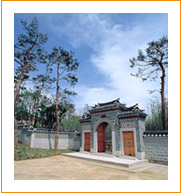
With such features
as Bohwamun
Gate (modeled after the Yuhyeon-mun Gate of Deoksugung Palace), a
bamboo grove (once a common sight in the gardens of ordinary homes),
the harmonious blending of Sowon Garden's pond and pavilion, and the
gyeryu flowing into the pond, visitors can experience the tranquil
atmosphere of old-time gardens. The most noteworthy attribute of Heewon
is its preservation of the traditions of the Korean garden. In fact, in
parts of Heewon, you can enjoy a beauty and atmosphere like that of
Changdeokgung Palace Huwon Garden. Korean gardens embody a philosophy
of adapting to nature in its
original state. The elements of a Korean garden include land,
structures, flowers and trees, streams and ponds, rocks and walls,
bridges and paths. A garden brings these elements together into harmony
within a defined space through an orderly and functional arrangement.
.
In a garden, Koreans enjoy a
sense of inner peace from becoming one with nature. Gardens can also
serve practical purposes, such as for growing fruit or medicinal herbs,
in addition to being delightful playgrounds. Sometimes they are used as
an inspirational backdrop for writing poetry, or a spiritual training
ground for meditation. The influences that shaped the identity of the
Korean garden include Korea's natural environment as well as the
lifestyle and ideological values of its people, which have changed with
the times.
 Architecture (Visit
http://web.edunet4u.net/~hanok/eng/main.htm to learn more about Korean
architecture.)
Architecture (Visit
http://web.edunet4u.net/~hanok/eng/main.htm to learn more about Korean
architecture.) Architecture (Visit
http://web.edunet4u.net/~hanok/eng/main.htm to learn more about Korean
architecture.)
Architecture (Visit
http://web.edunet4u.net/~hanok/eng/main.htm to learn more about Korean
architecture.)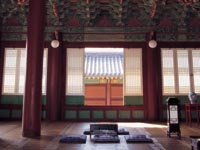
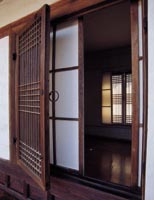
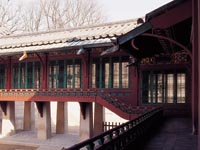
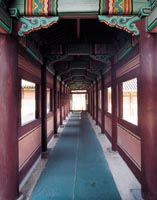
 meditation.
The influences that shaped the identity of the
Korean garden include Korea's natural environment as well as the
lifestyle and ideological values of its people, which have changed with
the times.
Nature in the Traditional Garden
The Korean peninsula's three
coasts are lapped by the ocean, while its mountains, rivers, fields,
and seas stand out in sharp contrast, amid a constant changing of its
distinctive seasons. Accordingly, the inhabitants of long ago spoke of
their beautiful land as "embroidered rivers and mountains." The land of
Korea is free from major earthquakes and active volcanoes. Rain falls
in quantities conducive for agriculture, while the climate is
relatively mild.
As a result, the people could
maintain a stable livelihood by working hard in accordance with the
principles of nature. It was thus natural for Koreans to think of
nature as a motherly being who takes care of mankind. To Koreans,
nature was both an eternal spiritual essence and a comforting maternal
figure. Accordingly, the indigenous religion of Korea was centered on
the worship of nature. Koreans believed that life would not be possible
unless the principles of nature were respected.
The conceptual roots of Korean
culture lie in the worship of nature. The imported ideology of Buddhism
was added to this around the fourth century, while Taoist thought
became widely disseminated about the seventh century. It was from this
ideological background that the Korean garden was created. From the
15th century, the Song Confucianism of Zhu xi became the ruling
ideology of Joseon, along with landscape architecture coming under the
influence of such concepts as yin-yang, the five elements, and
geomancy.
In particular, Song
Confucianism's view of nature strongly influenced Joseon gardens. It
was through these influences that Joseon art was created, with its
naturalistic style untouched by artifice, while a worldly, practical
lifestyle flourished, based on moderation and diligence. Indeed, this
led to the development of a highly humanistic and straight-forward
naturalistic culture.
Korea's cultural heritage
includes nothing as monumental or imposing as the Great Wall of China
or the Grand Canal that links the Yellow River to the Yangtze River.
This is because Koreans believe that anything so huge will overwhelm
and alienate human beings. On the other hand, Japanese have long
suffered from natural disasters such as earthquakes, volcanoes,
typhoons, and tidal waves. As such, they were able to survive only by
overcoming these menacing forces of nature. As a reflection of this,
Japanese gardens feature a contrived sense of aesthetics. All Oriental
gardens are rooted in concepts about nature, but because of differences
in their respective natural environment, lifestyle, and values, the
gardens of Korea, China, and Japan each possess their own unique
characteristics.
meditation.
The influences that shaped the identity of the
Korean garden include Korea's natural environment as well as the
lifestyle and ideological values of its people, which have changed with
the times.
Nature in the Traditional Garden
The Korean peninsula's three
coasts are lapped by the ocean, while its mountains, rivers, fields,
and seas stand out in sharp contrast, amid a constant changing of its
distinctive seasons. Accordingly, the inhabitants of long ago spoke of
their beautiful land as "embroidered rivers and mountains." The land of
Korea is free from major earthquakes and active volcanoes. Rain falls
in quantities conducive for agriculture, while the climate is
relatively mild.
As a result, the people could
maintain a stable livelihood by working hard in accordance with the
principles of nature. It was thus natural for Koreans to think of
nature as a motherly being who takes care of mankind. To Koreans,
nature was both an eternal spiritual essence and a comforting maternal
figure. Accordingly, the indigenous religion of Korea was centered on
the worship of nature. Koreans believed that life would not be possible
unless the principles of nature were respected.
The conceptual roots of Korean
culture lie in the worship of nature. The imported ideology of Buddhism
was added to this around the fourth century, while Taoist thought
became widely disseminated about the seventh century. It was from this
ideological background that the Korean garden was created. From the
15th century, the Song Confucianism of Zhu xi became the ruling
ideology of Joseon, along with landscape architecture coming under the
influence of such concepts as yin-yang, the five elements, and
geomancy.
In particular, Song
Confucianism's view of nature strongly influenced Joseon gardens. It
was through these influences that Joseon art was created, with its
naturalistic style untouched by artifice, while a worldly, practical
lifestyle flourished, based on moderation and diligence. Indeed, this
led to the development of a highly humanistic and straight-forward
naturalistic culture.
Korea's cultural heritage
includes nothing as monumental or imposing as the Great Wall of China
or the Grand Canal that links the Yellow River to the Yangtze River.
This is because Koreans believe that anything so huge will overwhelm
and alienate human beings. On the other hand, Japanese have long
suffered from natural disasters such as earthquakes, volcanoes,
typhoons, and tidal waves. As such, they were able to survive only by
overcoming these menacing forces of nature. As a reflection of this,
Japanese gardens feature a contrived sense of aesthetics. All Oriental
gardens are rooted in concepts about nature, but because of differences
in their respective natural environment, lifestyle, and values, the
gardens of Korea, China, and Japan each possess their own unique
characteristics. around
Wolseong, the site of the Silla royal palace from 101 to 935, are
Gyerim Grove and Anapji, the pond of Silla's East Palace. During the
Silla period, the pond was known as Wolji or "Moon Pond," and it was
not until the Joseon era that poets and men of letters started to call
it Anapji, "Wild Goose and Duck Pond," for its abundant growth of reeds
and duckweed that made it a popular rest stop for wild geese and ducks.
The 7,723-square-meter Gyerim
is Gyeongju's sacred woodland area and the birthplace of Kim Al-ji,
founder of the illustrious Gyeongju Kim clan. Thick with zelkova trees
and wangbeodeul (salix Koreensis Anderss.), it is known as Korea's
oldest woodland. Moreover, from A.D. 65 to 307, Gyerim was used as the
name of the Silla Kingdom itself. Home to the oldest trees of all
Korea's ancient gardens, this grove is steeped in legend.
The remains of Anapji, the
pond of Silla's East Palace, were uncovered by an excavation team in
1975. According to Samguksagi (History of the Three Kingdoms), in the
12th month of the 14th year of King Munmu's reign (A.D. 674), "a pond
was dug within the palace grounds, where artificial mountains were
constructed, and flowers, rare birds, and deer brought." The section on
Gyeongju in the Donggungnyeoji-seungnam (Augmented Survey of the
Geography of Korea) states: "Anapji lies to the north of Cheonjusa
Temple, where King Munmu created a pond within the palace grounds,
piled up stones to make mountains symbolizing the 12 peaks of Mt. Musan
(Wuehan in Chinese), and brought in flowers and birds. To the west is
the site of Imhaejeon Pavilion, whose stone foundation and steps remain
in an open field." Anapji Pond extends some 190 meters from east to
west as well as north to south, encompassing an area of 15,658 square
meters and with stone-trimmed banks. To the east and north of the pond,
artificial mountains were built to symbolize the 12 peaks of Mt. Musan,
while palace buildings stood to the west and south. The sloped eastern
bank resembled an exquisitely curved coastline, and within the pond
were three islands symbolizing Samsinsan, or "Three God Mountains."
Along the banks of the pond and the slopes of the man-made mountains
were three beautiful arrangements of about a thousand uniquely shaped
rocks, each a little less than a man's height.
Anapji was a garden conceived
as a scaled-down version of the world of Taoist immortals. The method
of arranging the intriguingly shaped rocks is similar to a technique
described in the oldest record of Japanese gardening, the 11th-century
Skuteiki. From this source, we can see that the entrance where the
water flowed in was also similar to a Japanese garden. It seems likely
that Korean garden landscaping influences were eventually transmitted
to Japan.
Changdeokgung Huwon Garden
around
Wolseong, the site of the Silla royal palace from 101 to 935, are
Gyerim Grove and Anapji, the pond of Silla's East Palace. During the
Silla period, the pond was known as Wolji or "Moon Pond," and it was
not until the Joseon era that poets and men of letters started to call
it Anapji, "Wild Goose and Duck Pond," for its abundant growth of reeds
and duckweed that made it a popular rest stop for wild geese and ducks.
The 7,723-square-meter Gyerim
is Gyeongju's sacred woodland area and the birthplace of Kim Al-ji,
founder of the illustrious Gyeongju Kim clan. Thick with zelkova trees
and wangbeodeul (salix Koreensis Anderss.), it is known as Korea's
oldest woodland. Moreover, from A.D. 65 to 307, Gyerim was used as the
name of the Silla Kingdom itself. Home to the oldest trees of all
Korea's ancient gardens, this grove is steeped in legend.
The remains of Anapji, the
pond of Silla's East Palace, were uncovered by an excavation team in
1975. According to Samguksagi (History of the Three Kingdoms), in the
12th month of the 14th year of King Munmu's reign (A.D. 674), "a pond
was dug within the palace grounds, where artificial mountains were
constructed, and flowers, rare birds, and deer brought." The section on
Gyeongju in the Donggungnyeoji-seungnam (Augmented Survey of the
Geography of Korea) states: "Anapji lies to the north of Cheonjusa
Temple, where King Munmu created a pond within the palace grounds,
piled up stones to make mountains symbolizing the 12 peaks of Mt. Musan
(Wuehan in Chinese), and brought in flowers and birds. To the west is
the site of Imhaejeon Pavilion, whose stone foundation and steps remain
in an open field." Anapji Pond extends some 190 meters from east to
west as well as north to south, encompassing an area of 15,658 square
meters and with stone-trimmed banks. To the east and north of the pond,
artificial mountains were built to symbolize the 12 peaks of Mt. Musan,
while palace buildings stood to the west and south. The sloped eastern
bank resembled an exquisitely curved coastline, and within the pond
were three islands symbolizing Samsinsan, or "Three God Mountains."
Along the banks of the pond and the slopes of the man-made mountains
were three beautiful arrangements of about a thousand uniquely shaped
rocks, each a little less than a man's height.
Anapji was a garden conceived
as a scaled-down version of the world of Taoist immortals. The method
of arranging the intriguingly shaped rocks is similar to a technique
described in the oldest record of Japanese gardening, the 11th-century
Skuteiki. From this source, we can see that the entrance where the
water flowed in was also similar to a Japanese garden. It seems likely
that Korean garden landscaping influences were eventually transmitted
to Japan.
Changdeokgung Huwon Garden
 The most significant
palace
garden remains of the Joseon era (1392-1910) is the Huwon garden of the
Changdeokgung Palace, commonly known as "Rear Garden." Built in 1405,
Changdeokgung served as a royal palace through 1910 for successive
kings of the Joseon Dynasty and the Emperor of the Daehan Empire
(1897-1910). In 1997, Changdeokgung and its Huwon garden was added to
the list of UNESCO World Heritage properties, making this
world-acclaimed garden a must-see attraction for sightseers in Seoul.
The Huwon garden covers an
area of about 300,000 square meters, with its highest point reaching 98
meters above sea level. Arranged in harmony with the landscape, and not
unduly dominating the hillside, are 17 pavilions, including
Buyongjeong, Aeryeonjeong, Huiujeong, Jondeokjeong, Taegeukjeong, and
Cheongsimjeong. Nearby buildings include Juhamnu, Yeongyeongdang,
Yeonghwadang, and
The most significant
palace
garden remains of the Joseon era (1392-1910) is the Huwon garden of the
Changdeokgung Palace, commonly known as "Rear Garden." Built in 1405,
Changdeokgung served as a royal palace through 1910 for successive
kings of the Joseon Dynasty and the Emperor of the Daehan Empire
(1897-1910). In 1997, Changdeokgung and its Huwon garden was added to
the list of UNESCO World Heritage properties, making this
world-acclaimed garden a must-see attraction for sightseers in Seoul.
The Huwon garden covers an
area of about 300,000 square meters, with its highest point reaching 98
meters above sea level. Arranged in harmony with the landscape, and not
unduly dominating the hillside, are 17 pavilions, including
Buyongjeong, Aeryeonjeong, Huiujeong, Jondeokjeong, Taegeukjeong, and
Cheongsimjeong. Nearby buildings include Juhamnu, Yeongyeongdang,
Yeonghwadang, and Seonhyangjae. The ponds, mostly round in shape,
include Buyongji, Aeryeonji, Jondeokji, Banwolji, Eosutaekji, and
Gwallamjeongji.
Seonhyangjae. The ponds, mostly round in shape,
include Buyongji, Aeryeonji, Jondeokji, Banwolji, Eosutaekji, and
Gwallamjeongji.
 The area is home to
several
extraordinary trees, including a 700-year-old darae namu (Actinidia
arguta), 600-year-old Chinese juniper, and zelkova tree several hundred
years old, along with various dolbae namu (Rosaceae Pyrus pyrifolia
(Burm.) Nakai), mulberry, chestnut, yew, pagoda tree, white oak, and
overcup oak. There are also shrubs and bushes under 3 meters in height:
about 300 species of plants in all. Among them, these darae namu and
Chinese juniper have been designated natural monuments.
Distinctively shaped rocks are
arranged around the pavilions, walls, and flowerbeds, together with
landscaping along the sloping banks. Attractive stone bridges cross a
little stream. There are fruit trees, mulberry trees for silk worms,
apricots, Japanese apricots, cherries, and peonies, while taller trees
such as zelkova and pagoda trees form a lush woodland.
Although Huwon is a man-made
garden, its natural beauty is magnificent. Walking the 2-kilometer path
through the garden, people can feel that they have become one with
nature. In fact, Korean kings would often visit the garden to consult
with their confidants and contemplate weighty matters.
Heewon Garden
Soswaewon garden, located in
Jigok-ri Village, Nam-myeon, Damyang-gun, Jeollanam-do province, was
created by the scholar Yang San-bo during the reign of Joseon's King
Jungjong (r. 1506-1544). Within a 9,900-square-meter area surrounded by
boulders, Gwangpunggak Pavilion, Jewoldang Hall, flowerbeds, ponds, a
single-log bridge, and a water wheel create a picturesque landscape.
The garden is imbued with the philosophy of scholars who enjoyed a
self-sufficient lifestyle while immersed in nature and scholarly
pursuits.
Soswaewon clearly reflects its
creator's desire to abide by the principles of nature. In particular,
the garden makes extensive use of natural features, whose original
state is maintained as much as possible. The garden is a representation
of the ideal world that scholars sought to find when they retreated
from public life to the
The area is home to
several
extraordinary trees, including a 700-year-old darae namu (Actinidia
arguta), 600-year-old Chinese juniper, and zelkova tree several hundred
years old, along with various dolbae namu (Rosaceae Pyrus pyrifolia
(Burm.) Nakai), mulberry, chestnut, yew, pagoda tree, white oak, and
overcup oak. There are also shrubs and bushes under 3 meters in height:
about 300 species of plants in all. Among them, these darae namu and
Chinese juniper have been designated natural monuments.
Distinctively shaped rocks are
arranged around the pavilions, walls, and flowerbeds, together with
landscaping along the sloping banks. Attractive stone bridges cross a
little stream. There are fruit trees, mulberry trees for silk worms,
apricots, Japanese apricots, cherries, and peonies, while taller trees
such as zelkova and pagoda trees form a lush woodland.
Although Huwon is a man-made
garden, its natural beauty is magnificent. Walking the 2-kilometer path
through the garden, people can feel that they have become one with
nature. In fact, Korean kings would often visit the garden to consult
with their confidants and contemplate weighty matters.
Heewon Garden
Soswaewon garden, located in
Jigok-ri Village, Nam-myeon, Damyang-gun, Jeollanam-do province, was
created by the scholar Yang San-bo during the reign of Joseon's King
Jungjong (r. 1506-1544). Within a 9,900-square-meter area surrounded by
boulders, Gwangpunggak Pavilion, Jewoldang Hall, flowerbeds, ponds, a
single-log bridge, and a water wheel create a picturesque landscape.
The garden is imbued with the philosophy of scholars who enjoyed a
self-sufficient lifestyle while immersed in nature and scholarly
pursuits.
Soswaewon clearly reflects its
creator's desire to abide by the principles of nature. In particular,
the garden makes extensive use of natural features, whose original
state is maintained as much as possible. The garden is a representation
of the ideal world that scholars sought to find when they retreated
from public life to the solitude of the countryside.
Deep in a valley on Bogildo
Island, Wando-gun, Jeollanam-do, lies Buyongjeong, a garden created by
the Joseon poet Yun Seon-do. At the entrance to the garden, Yun built
Seyeonjeong Pavilion, alongside a gyeryu (small stream), and a
2,000-square-meter pond with banks formed of flat stones about 11
meters in length. Nearby, he built another pond of about 820 square
meters in area, in addition to installing Dongdae and Seodae platforms,
a stone bridge, and Seyeonjeong Pavilion. Deeper into the valley, he
built Dongcheonseoksil, a one-room pavilion that he used as a study. On
the slope of a hill across the valley, he constructed Nakseojae, a hall
where he instructed young scholars. The woods of Buyongjeong were the
birthplace of the literary figure Yun Seon-do, author of Eobusasisa
(The Four Seasons of the Fisherman), and a retreat for literati to
commune with nature.
A garden that adopts these
elements of traditional landscape architecture is Heewon, created in
1997 at the Ho-am Art Museum. Heewon is based on a "principle of
borrowed scenery" (a technique of bringing natural scenery into a
garden setting) that forms the foundation of traditional garden
aesthetics. On a site of about 6,000 square meters, the garden restores
the topographic contours of long ago and highlights the features of
traditional garden landscaping: stone steps and pavilions, ponds, and
walls.
solitude of the countryside.
Deep in a valley on Bogildo
Island, Wando-gun, Jeollanam-do, lies Buyongjeong, a garden created by
the Joseon poet Yun Seon-do. At the entrance to the garden, Yun built
Seyeonjeong Pavilion, alongside a gyeryu (small stream), and a
2,000-square-meter pond with banks formed of flat stones about 11
meters in length. Nearby, he built another pond of about 820 square
meters in area, in addition to installing Dongdae and Seodae platforms,
a stone bridge, and Seyeonjeong Pavilion. Deeper into the valley, he
built Dongcheonseoksil, a one-room pavilion that he used as a study. On
the slope of a hill across the valley, he constructed Nakseojae, a hall
where he instructed young scholars. The woods of Buyongjeong were the
birthplace of the literary figure Yun Seon-do, author of Eobusasisa
(The Four Seasons of the Fisherman), and a retreat for literati to
commune with nature.
A garden that adopts these
elements of traditional landscape architecture is Heewon, created in
1997 at the Ho-am Art Museum. Heewon is based on a "principle of
borrowed scenery" (a technique of bringing natural scenery into a
garden setting) that forms the foundation of traditional garden
aesthetics. On a site of about 6,000 square meters, the garden restores
the topographic contours of long ago and highlights the features of
traditional garden landscaping: stone steps and pavilions, ponds, and
walls.
 With such features
as Bohwamun
Gate (modeled after the Yuhyeon-mun Gate of Deoksugung Palace), a
bamboo grove (once a common sight in the gardens of ordinary homes),
the harmonious blending of Sowon Garden's pond and pavilion, and the
gyeryu flowing into the pond, visitors can experience the tranquil
atmosphere of old-time gardens. The most noteworthy attribute of Heewon
is its preservation of the traditions of the Korean garden. In fact, in
parts of Heewon, you can enjoy a beauty and atmosphere like that of
Changdeokgung Palace Huwon Garden. Korean gardens embody a philosophy
of adapting to nature in its
original state. The elements of a Korean garden include land,
structures, flowers and trees, streams and ponds, rocks and walls,
bridges and paths. A garden brings these elements together into harmony
within a defined space through an orderly and functional arrangement.
In a garden, Koreans enjoy a
sense of inner peace from becoming one with nature. Gardens can also
serve practical purposes, such as for growing fruit or medicinal herbs,
in addition to being delightful playgrounds. Sometimes they are used as
an inspirational backdrop for writing poetry, or a spiritual training
ground for meditation. The influences that shaped the identity of the
Korean garden include Korea's natural environment as well as the
lifestyle and ideological values of its people, which have changed with
the times.
With such features
as Bohwamun
Gate (modeled after the Yuhyeon-mun Gate of Deoksugung Palace), a
bamboo grove (once a common sight in the gardens of ordinary homes),
the harmonious blending of Sowon Garden's pond and pavilion, and the
gyeryu flowing into the pond, visitors can experience the tranquil
atmosphere of old-time gardens. The most noteworthy attribute of Heewon
is its preservation of the traditions of the Korean garden. In fact, in
parts of Heewon, you can enjoy a beauty and atmosphere like that of
Changdeokgung Palace Huwon Garden. Korean gardens embody a philosophy
of adapting to nature in its
original state. The elements of a Korean garden include land,
structures, flowers and trees, streams and ponds, rocks and walls,
bridges and paths. A garden brings these elements together into harmony
within a defined space through an orderly and functional arrangement.
In a garden, Koreans enjoy a
sense of inner peace from becoming one with nature. Gardens can also
serve practical purposes, such as for growing fruit or medicinal herbs,
in addition to being delightful playgrounds. Sometimes they are used as
an inspirational backdrop for writing poetry, or a spiritual training
ground for meditation. The influences that shaped the identity of the
Korean garden include Korea's natural environment as well as the
lifestyle and ideological values of its people, which have changed with
the times.